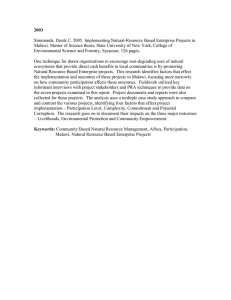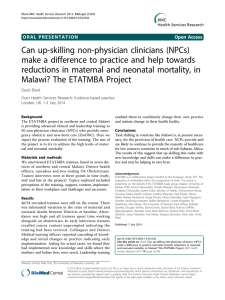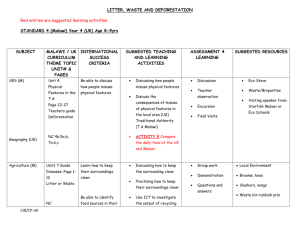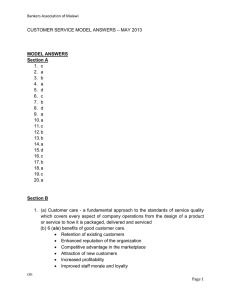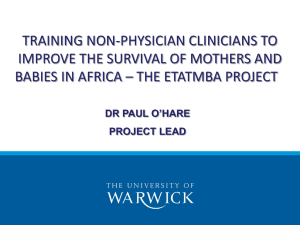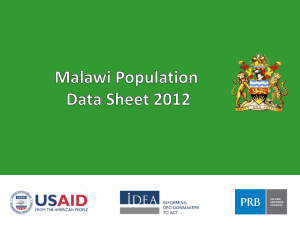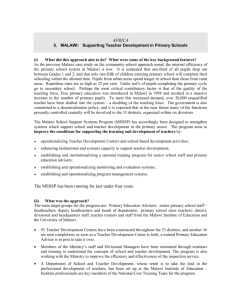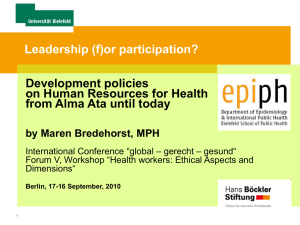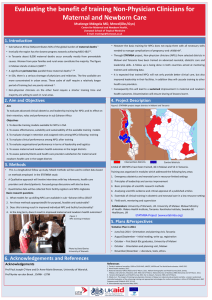The ETATMBA Project in Malawi: Project ‘Trial’ to evaluate the project
advertisement
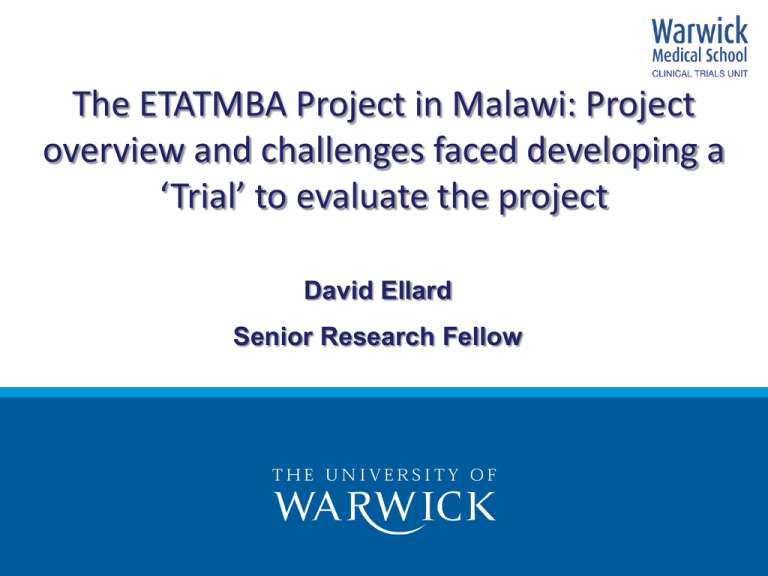
The ETATMBA Project in Malawi: Project overview and challenges faced developing a ‘Trial’ to evaluate the project David Ellard Senior Research Fellow Overview • “Malawi, where is Malawi”? • Some facts about Malawi • General • Healthcare • Introduction to ETATMBA • Project aims • Research project • • • • Aims & objectives Methods Challenges! The future “The Warm Heart of Africa” Facts about Malawi (General) Malawi is 45.7472 miles (118.4832 km) in size England is 50.3462 miles (130.3952 km) Malawi (formally Nyasaland)Was a British Colony until 1964 Lake Malawi (Lake Nyasa) 3rd largest in Africa 8th in world Main language is English (and they drive on the left!) Population is currently about 15 Million Predicted to rise to 45 Million by 2050 80% are Christian and about 13% Muslim Education: Entitled to 5 years primary education (not compulsory) Uptake is low but improving A resource poor country (some tobacco, sugar, tea etc…) Agriculture, Subsistence farming (Maize being main crop) Main Health Issues Life expectancy at birth: Total population: 51.7 years Male: 50.93 years Female: 52.48 years • HIV/AIDS – WHO suggest 13% of population but data from 2007 (Just under 1 Million people living with HIV/AIDS) • Malaria • Maternal and Neonatal Mortality (2011 estimates WHO) Healthcare Spend Per Capita (USD) USA, $7,410* UK, $3,399* Malawi, $50* *Source: WHO (Global Health Observatory, 2009) ETATMBA: (Enhancing Training and Appropriate Technologies for Mothers and Babies in Africa) ETATMBA is a European Commission FP7 funded project being delivered in Tanzania and Malawi Partners: • The University of Warwick (UK) • Karolinska Institute (Sweden) • Ifakara Health Institute, Tanzania • The University of Malawi • The Ministry of Health (Malawi) • GE Healthcare (UK) My Focus is on the work in Malawi Project Team Prof. Winstanley, University of Warwick, UK Dr Paul O'Hare, University of Warwick, UK Prof Siobhan Quenby, University of Warwick, UK Dr Doug Simkiss, University of Warwick, UK Dr Chisale Mhango, College of Medicine, Malawi Dr Francis Kamwendo, College of Medicine, Malawi Anne-Marie Brennan, University of Warwick (study Manager) David Davies, University of Warwick David Ellard, University of Warwick Kandala Ngianga-bakwin University of Warwick (statistician) And others… ETATMBA (Enhancing Training and Appropriate Technologies for Mothers and Babies in Africa) Very few Medical Doctors in Malawi – 260* approximately 1 Medical Doctor per 50,000 people Similar to other African Countries much of this work is done by: Non-Physician Clinicians (NPCs) *Data from 2009 Non-Physician Clinicians (NPC’s) “The crisis in human healthcare resources disproportionately affects the poorest women in low income countries.” “Are non-physician clinicians a substandard solution to the crisis in human resources for maternal health?” “Evidence suggests that the answer is no.” Bergström , BMJ 2011;342:d2499 doi: 10.1136/bmj.d2499 ETATMBA The project is to train 50 NonPhysician Clinicians (NPCs) as advanced leaders providing them with skills and knowledge in advanced neonatal and obstetric care (over a 24 month period). Training it is hoped that will be cascaded to their colleagues (other NPCs, midwives, nurses). The aim of the project is to try and address the high levels of maternal and neonatal mortality. Evaluating the impact of ETATMBA The aim of this study is to: • Evaluate the impact on healthcare outcomes of the ETATMBA training in Malawi. OUTCOMES (Primary): • Perinatal mortality (defined as fresh stillbirths and neonatal deaths before discharge from the health care facility) OUTCOMES (Secondary): • Maternal death rates; • Recorded data (e.g. still births, Post-Partum Haemorrhage, C Section, Eclampsia, Sepsis, • Neonatal resuscitation); • Availability of resources (e.g. are drugs/blood available); • Use of available resources (e.g. are drugs being used). Design & Methods Cluster Randomised Controlled Trial with a Process Evaluation • 8 of the 14 districts from Central and Northern Malawi are randomised to the intervention Methods (Mixed) • Quantitative (hospital outcome data) • Qualitative(interviews with key stakeholders) Power & Sample Size We computed a sample size for proportion in an unmatched study with 80% power, a one sided alpha of 0.05, and an ICC 0.0025. The current neonatal mortality rate in Malawi: is 30 per 1000 live births (source UNICEF) and assuming a minimum number of clusters of 14 in our sampled districts, the study was powered to detect a 20% difference between the two birth cohorts (intervention and control) in the proportion of live-born neonates delivered by NPCs or staff trained by them) surviving to hospital discharge. With the allocation of 7 districts per arm with an estimated 700 births per NPC (or staff trained by them), 1028 births per study arm per district would provide sufficient power for a total of 2056 neonates per district. That is, a decline from 30 per 1000 live births to 24 per 1000 live births, rate ratio 0.20. Quantitative data Primary data will be extracted from the maternity log and or the summary reports at the district hospitals All health facilities in a district return this data to the district hospital on a monthly basis Data are to be collected retrospectively at three points in time: 1. For the 12 months leading up to start of project (Baseline) 2. At the end of the first year 3. At the end of the second year Qualitative data Exploring attitudes and behaviours Have we made a difference to practice? In depth interviews with: • NPC’s • District Medical Officers • District Nursing Officers • Cascades' (who are trained by NPCs) • Supervisors and tutors Baseline, 12 months and 24 months Challenges! – Ethics and approvals – Resources! • Limited funds for research component • Travel (distances) • Electricity & Internet – Access to data – Oversight from a distance The future! • Exploring more costeffective ways to collect primary data • To continue to gather interview data • More monitoring visits?? • Research opportunities Thank you for listening Any Questions?
